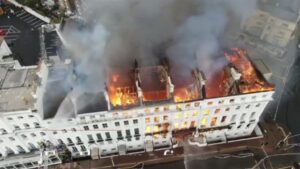Los Angeles, often associated with glitz and glamour, is home to a plethora of hotels that cater to the diverse needs of tourists and locals alike. While these establishments strive to provide a comfortable and secure environment, the unforeseen can happen, leading to catastrophic events like fires. Fire incidents in hotels not only pose a threat to human lives but also result in extensive property damage. This is where the crucial role of fire damage restoration comes into play.
In this comprehensive guide, we will explore the various scenarios when a Los Angeles hotel might need fire damage restoration. From understanding the causes of hotel fires to assessing the aftermath and the restoration process, we will delve into the intricacies of safeguarding these hospitality havens.
Common Causes of Hotel Fires
Hotel fires can be ignited by various factors, each posing a unique set of challenges for the property and its occupants. Faulty electrical wiring, kitchen mishaps, heating equipment malfunctions, and even arson are among the primary culprits. In Los Angeles, with its diverse climate and seismic activity, understanding these potential causes is crucial for hotel owners and managers to implement preventive measures.
Immediate Aftermath: Assessing the Extent of Damage
Once a fire has been extinguished, the aftermath is a chaotic scene of charred structures, water damage from firefighting efforts, and pervasive smoke residue. Hotel owners and management must conduct a thorough assessment to gauge the extent of the damage. This involves evaluating structural integrity, identifying salvageable items, and assessing the impact on essential systems like plumbing and electrical.
Health and Safety Concerns
Beyond the visible damage, hotels face health and safety concerns after a fire. The lingering smoke and soot particles can permeate the air, posing respiratory risks to guests and staff. Proper air quality assessments and remediation efforts are essential to ensure a safe environment for all.
Restoration Challenges Specific to Hotels
Hotels, being multi-story structures with intricate designs, present unique challenges for fire damage restoration. The restoration process must address not only the structural components but also the specialized features such as elevators, HVAC systems, and extensive plumbing networks. Coordinating restoration efforts across multiple floors and sections of the hotel demands meticulous planning and execution.
Preserving the Reputation of the Hotel
A fire incident in a hotel can have lasting repercussions on its reputation. Guests often choose hotels based on their perception of safety and comfort. Effective communication during and after the restoration process is crucial to rebuild trust. Implementing transparent communication strategies and showcasing the commitment to safety can go a long way in preserving the hotel’s reputation.
Insurance Claims and Documentation
Navigating the insurance claim process is a critical aspect of post-fire recovery. Hotel owners need to document the damage thoroughly, including before-and-after photographs, detailed reports, and estimates for restoration costs. Collaborating with insurance professionals who specialize in fire damage claims can streamline the process and ensure that the hotel receives fair compensation.
Choosing the Right Fire Damage Restoration Professionals
Not all restoration companies are equipped to handle the complexities of hotel fire damage. Selecting experienced professionals with a track record in large-scale commercial restoration is essential. The restoration team should have the expertise to address structural concerns, specialized systems, and the unique challenges presented by the hospitality industry.
Implementing Preventive Measures for Future Incidents
While fire damage restoration is a crucial step in recovery, preventing future incidents is equally important. Hotels can invest in advanced fire detection and suppression systems, conduct regular safety drills for staff, and ensure that all electrical and heating equipment is regularly inspected and maintained. Proactive measures can significantly reduce the risk of future fire-related disasters.
Conclusion
In the bustling landscape of Los Angeles hotels, the threat of fire is a reality that cannot be ignored. Swift and effective fire damage restoration Los Angeles is essential not only for the structural integrity of the property but also for preserving the reputation and safety of the establishment. By understanding the common causes of hotel fires, addressing immediate aftermath challenges, and implementing preventive measures, hotel owners can mitigate risks and provide a secure environment for guests and staff alike.
The road to recovery post-fire involves collaboration with experienced restoration professionals, meticulous documentation for insurance claims, and a commitment to transparent communication with stakeholders. Ultimately, a well-executed fire damage restoration plan not only restores the physical aspects of a hotel but also ensures its resilience in the face of unforeseen challenges. In safeguarding luxury, hotels in Los Angeles can emerge stronger, more secure, and ready to welcome guests with confidence.
Related posts:
- The Powerhouse of Performance: Why Every Hotel Needs Goulds 3196 Pumps
- Fueling Hospitality: How Oil and Gas Valuation Can Finance Hotels and Operations
- Embracing Wisdom and Wellness: The Benefits of Hiring a Senior Citizen Personal Trainer for Hotels
- The Essential Guide: When Do Hotels Need to Hire Chemical Disposal Companies?

